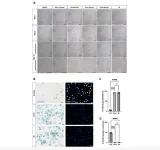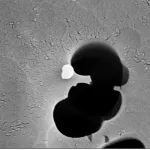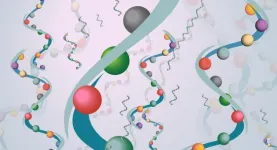(Press-News.org) Currently, most therapies for allergic diseases require lifelong treatment. Allergic reactions, characterized by ongoing (type 2) inflammation in response to chronic antigen exposure, underlie many chronic diseases in humans, including asthma, atopic dermatitis, ulcerative colitis and more. T helper 2 (Th2) cells play an important role in the body's immune response, particularly in allergic reactions. Despite their central role, the sustained activity of Th2 cells during allergic reactions, even in the face of constant antigen exposure, has long puzzled researchers.
A research team that included authors from Mass General Brigham, including members Brigham and Women’s Hospital, Massachusetts General Hospital, and Mass Eye and Ear, embarked on a quest to understand the diversity and cellular mechanisms of human Th2 cells. By conducting gene expression analyses of inflamed tissues, they pinpointed a subset of Th2 cells called Th2-MPP cells. Their findings suggested that these cells might serve as precursors to several crucial Th2 cell populations responsible for disease symptoms. These discoveries lay the groundwork for therapeutic interventions targeting these cells, potentially offering relief to patients living with allergic diseases. Results are published in Nature Immunology.
The research team created a single cell transcriptomic atlas, a comprehensive database of genes that are turned “on” and “off” in individual cells in the body, using inflamed tissues from patients with nine different chronic allergic diseases. They used this atlas to identify Th2-multipotent progenitor (Th2-MPP) cells, which chronically expressed two transcription factors, TCF7 and LEF1. These transcription factors allowed Th2-MPP cells to exhibit characteristics similar to stem cells in cancer and chronic infection, acting as progenitor cells that can give rise to other kinds of cells. The team also performed detailed studies on Th2 cells from nasal tissue in patients with chronic rhinosinusitis. They found that Th2-MPP cells could be the precursor for multiple types of Th2 cells that cause disease symptoms.
“We still have much to learn about the contribution of progenitor cells to chronic human inflammation, but we are hopeful that the study of this area of immunity could provide opportunities for future disease-modifying therapeutic approaches,” said senior author Patrick Brennan, MD, PhD, a physician-researcher in the Brigham Division of Allergy and Clinical Immunology.
“Our work suggests that Th2-MPP cells have the potential to sustain type 2 inflammation in the face of chronic antigen exposure and lays the foundation for further investigation to better understand their contribution to disease,” said lead author Radomir Kratchmarov, MD, a research fellow in the Brigham Division of Allergy and Clinical Immunology.
Authorship: Other Mass General Brigham authors include Garrett Dunlap (BWH), Wenqin He (BWH), Xiaojiong Jia (BWH), Caitlin M. Burk (MGH), Tessa Ryan (BWH), Alanna McGill (BWH) Jessica R. Allegretti (BWH), Erin M. Taylor (BWH), Shailesh Agarwal (BWH), Neil Bhattacharyya (Mass Eye and Ear), Regan W. Bergmark (BWH), Alice Z. Maxfield (BWH), Stella Lee (BWH), Rachel Roditi (BWH), Daniel F. Dwyer (BWH), Joshua A. Boyce (BWH), Kathleen M. Buchheit (BWH), Tanya M. Laidlaw (BWH), Wayne G. Shreffler (MGH), and Deepak A. Rao (BWH). Additional authors include Sarah Djeddi, Raghu P. Kataru, Babak J. Mehrara, Maria Gutierrez-Arcelus.
Disclosures: Lee reports clinical trial funding from Sanofi Aventis Regeneron, GlaxoSmithKline, AstraZeneca and OptiNose and participated on advisory boards for GlaxoSmithKline, AstraZeneca, Sanofi Aventis, Regeneron, Genentech and Novartis. Bergmark reports unrelated clinical trial funding from I-Mab Biopharma (CTA: HLW-ALZ-NAS-001). Bhattacharyya reports consultant fees for unrelated epidemiology research for GlaxoSmithKline. Rao reports consultant fees for unrelated work from GlaxoSmithKline, AstraZeneca, Pfizer, HiFiBio Therapeutics, Scipher Medicine and Bristol-Myers Squibb and grant support unrelated to this work from Janssen, Merck and Bristol-Myers Squibb. Dwyer reports unrelated consultant fees from Celldex Therapeutics.
Funding: This work was supported by National Institutes of Health (grants U19AI095219, T32AI007306 and K23AI139352), the Lupus Research Alliance, the Food Allergy Science Initiative (FASI) at the Broad Institute, the Arthritis National Science Foundation Vic Braden Family Fellowship and generous support from the Vinik and Karol Families.
Paper cited: Kratchmarov, R., Djeddi, S., Dunlap, G. et al. TCF1–LEF1 co-expression identifies a multipotent progenitor cell (TH2-MPP) across human allergic diseases. Nat Immunol (2024). https://doi.org/10.1038/s41590-024-01803-2
END
Mass General Brigham researchers identify potential drivers of chronic allergic inflammation
2024-04-30
ELSE PRESS RELEASES FROM THIS DATE:
Scientists solve chemical mystery at the interface of biology and technology
2024-04-30
Link to release:
https://www.washington.edu/news/2024/04/30/oects/
Researchers who want to bridge the divide between biology and technology spend a lot of time thinking about translating between the two different “languages” of those realms.
“Our digital technology operates through a series of electronic on-off switches that control the flow of current and voltage,” said Rajiv Giridharagopal, a research scientist at the University of Washington. “But our bodies operate on chemistry. In our brains, neurons ...
Shaping the Future of Neuroendocrine Tumor Management
2024-04-30
MIAMI, FLORIDA (April 30, 2024) – Newly updated guidelines on neuroendocrine tumors developed by an expert at Sylvester Comprehensive Cancer Center at the University of Miami Miller School of Medicine and collaborators provide clinicians with the latest recommendations for staging and management of these rare but increasingly diagnosed tumors.
The guidelines, developed for the American Joint Committee on Cancer (AJCC) and summarized today in CA: A Cancer Journal for Clinicians, highlight recent changes for treating these tumors and offer a snapshot of this rapidly evolving ...
Scientists show ancient village adapted to drought, rising seas
2024-04-30
Around 6,200 BCE, the climate changed. Global temperatures dropped, sea levels rose and the southern Levant, including modern-day Israel, the Palestinian territories, Jordan, Lebanon, southern Syria and the Sinai desert, entered a period of drought.
Previously, archaeologists believed that this abrupt shift in global climate, called the 8.2ka event, may have led to the widespread abandonment of coastal settlements in the southern Levant. In a recent study published with the journal Antiquity, researchers at UC San Diego, the University of Haifa and Bar-Ilan University share new evidence suggesting at least one village formerly thought abandoned not only remained occupied, but ...
Cover paper: Senescent characteristics of human corneal endothelial cells upon UV-A exposure
2024-04-30
“[...] these findings may help to advance our understanding of the pathogenesis of corneal endothelial disease and may lead to the discovery of new therapies targeting senescent cells.”
BUFFALO, NY- April 30, 2024 – A new research paper was published on the cover of Aging (listed by MEDLINE/PubMed as "Aging (Albany NY)" and "Aging-US" by Web of Science) Volume 16, Issue 8, entitled, “Senescent characteristics of human corneal endothelial cells upon ultraviolet-A exposure.”
In ...
Activity in a room stirs up nanoparticles left over from consumer sprays
2024-04-30
Common household products containing nanoparticles – grains of engineered material so miniscule they are invisible to the eye – could be contributing to a new form of indoor air pollution, according to a Rutgers study.
In a study published in the journal Science of the Total Environment, a team of Rutgers researchers found people walking through a space, where a consumer product containing nanoparticles was recently sprayed, stirred residual specks off carpet fibers and floor surfaces, projecting them some three ...
NASA’s Webb maps weather on planet 280 light-years away
2024-04-30
An international team of researchers has successfully used NASA’s James Webb Space Telescope to map the weather on the hot gas-giant exoplanet WASP-43 b.
Precise brightness measurements over a broad spectrum of mid-infrared light, combined with 3D climate models and previous observations from other telescopes, suggest the presence of thick, high clouds covering the nightside, clear skies on the dayside, and equatorial winds upwards of 5,000 miles per hour mixing atmospheric gases around the planet.
The investigation is just the latest demonstration of the exoplanet science now possible with Webb’s ...
Webb captures top of iconic horsehead nebula in unprecedented detail
2024-04-30
NASA’s James Webb Space Telescope has captured the sharpest infrared images to date of a zoomed-in portion of one of the most distinctive objects in our skies, the Horsehead Nebula. These observations show the top of the “horse’s mane” or edge of this iconic nebula in a whole new light, capturing the region’s complexity with unprecedented spatial resolution.
Webb’s new images show part of the sky in the constellation Orion (The Hunter), in the western side of a dense region known as the Orion B molecular cloud. Rising from turbulent waves of dust and gas is the Horsehead Nebula, otherwise known as ...
Researchers reveal a new approach for treating degenerative diseases
2024-04-30
Proteins are the workhorses of life. Organisms use them as building blocks, receptors, processors, couriers and catalysts. A protein’s structure is critical to its function. Malformed proteins not only fail to carry out their tasks, they can accumulate and eventually gum up the inner workings of cells. As a result, misfolded proteins cause a variety of degenerative diseases, from Alzheimer’s and Parkinson’s to the blinding disease retinitis pigmentosa. These disorders are currently incurable.
A paper out of UC Santa Barbara reveals a new connection between ...
People who inject drugs are transitioning to smoking
2024-04-30
Researchers from the University of California San Diego have revealed new trends in drug consumption that shed light on how people are adapting to the evolving risks associated with unregulated drug use in the United States. The findings could help policymakers and public health officials better tailor interventions to meet the needs of vulnerable populations and reduce the public health burden of substance-related harm.
Since the early 2010s, deaths from accidental overdoses have been on the rise ...
AI speech analysis may aid in assessing and preventing potential suicides, says Concordia PhD candidate Alaa Nfissi
2024-04-30
Speech is critical to detecting suicidal ideation and a key to understanding the mental and emotional state of people experiencing it. Suicide hotline counsellors are trained to quickly analyze speech variation to better help callers through a crisis.
But just as no system is perfect, there is room for error in interpreting a caller’s speech. In order to assist hotline counsellors to properly assess a caller’s condition, Concordia PhD student Alaa Nfissi has developed a model for speech emotion recognition (SER) using artificial intelligence tools. The model analyzes and codes waveform modulations in ...






